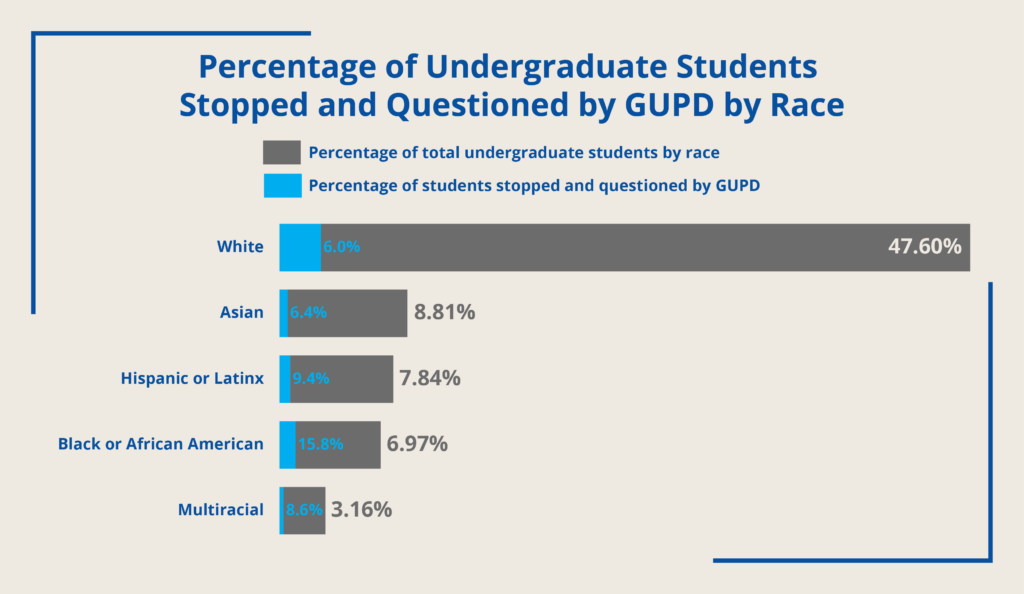Georgetown University’s first cultural climate survey revealed tensions between students and the Georgetown University Police Department, as results show students of color reported being disproportionately stopped by GUPD.
Of the undergraduate students surveyed, 7% reported having been stopped and questioned by GUPD. These results include 15.8% of Black/African American students, followed by 9.4% of Hispanic/Latinx students, 8.6% of multiracial students, 6.4% of Asian students, 6% of White students and 4.8% of international students who reported they were stopped by GUPD in the past year. The university’s student body in 2019 was 47.6% White, 8.81% Asian, 7.84% Hispanic/Latinx and 6.97% Black/African American.
GUPD is beyond repair and should be replaced with a more equitable oversight system on campus, according to Georgetown University Student Association Senator Ace Frazier (MSB ’23), who also serves as GUSA’s equity and inclusion policy director and a member of its GUPD abolition working group.

“You cannot fix a foundational oppressive system and the culture it creates on Georgetown University campus is the same it creates across the nation,” Frazier wrote in an email to The Hoya. “I believe we need to establish a 5-year plan to defund and eventually abolish GUPD in order to help keep students safe.”
In past years, students have raised complaints about hyperpolicing on Georgetown’s campus. In particular, students of color have experienced unnecessary surveillance and excessive use of force from GUPD. Last October, GUSA senators established a GUPD Abolition Working Group, which is advocating for GUPD’s abolition by engaging the university and educating the Georgetown community.
The results of the cultural climate survey have served as a call to action for GUPD, according to Associate Vice President for Public Safety and Chief of Police Jay Gruber.
“We are committed to continuing to improve our processes and procedures and to ensure there is no racial bias in GUPD actions as we strive to ensure that all members of our community feel safe on campus,” Gruber wrote in an email to The Hoya. “Our Officers have a deep respect for the diversity of the Georgetown community and are committed to serving and protecting our community in a fair and impartial manner that promotes respect and inclusiveness.”
In the wake of the Georgetown community backlash against racial disparities in police treatment, Gruber said GUPD has initiated reforms. Among these initiatives are enhanced implicit bias, de-escalation and antiracism training for all officers; requiring officers to track and record all stops and identification checks; and providing students with information about their rights and how to report bias, according to Gruber.
Originally, administrators did not plan to include additional Georgetown-specific questions in the survey, instead drafting questions based on the National Institute for Transformation and Equity questionnaire, a survey developed to measure inclusivity and equity on campuses across the country. However, after soliciting student input, students called on the university to include Georgetown-specific questions. Following student advocacy and a 2019 GUSA petition, the university agreed to add questions regarding policing, bias in the classroom, curriculum inclusivity, intersectional identities and accessibility.
After consulting with students, the university ensured all survey questions and instruments underwent an extensive process of development, testing and validation to ensure a balanced survey and accurate results, according to a university spokesperson.
“Items were constructed using existing research and assessment and data from across the nation, and systematic methods were used to assess the content and construct validity of the surveys,” the spokesperson wrote in an email to The Hoya.
Despite student advocacy efforts for the inclusion of Georgetown-specific questions related to law enforcement, only one question on the published survey referred to GUPD, according to Frazier.
“The survey entirely and I believe intentionally neglected to ask student perception of GUPD in terms of their usefulness as a resource,” Frazier wrote. “They also did not ask about how safe people feel when they think about GUPD. These are vital questions to determine GUPD’s success at their job and in order to evaluate whether they serve any purpose to Georgetown University.”
The changes GUPD has already initiated represent continued efforts to combat racial disparity at Georgetown, according to Vice President of Diversity, Equity and Inclusion and Chief Diversity Officer Rosemary Kilkenny (LAW ’87), who said the university has plans to conduct another survey to measure its progress.
“I look forward to continuing joint efforts with Chief Gruber to address the concerns raised by students in the survey,” Kilkenny wrote in an email to The Hoya.
To get broader and more specific information on GUPD relations, the university should conduct a more specific survey to better gauge students’ experiences with GUPD, according to Frazier.
“I hope to see a GUPD specific survey that asks relevant questions relating to the practices and culture around GUPD,” Frazier wrote. “I guarantee many would be interested in such a survey and that the results would be very telling of what actions to take going forward.”




















